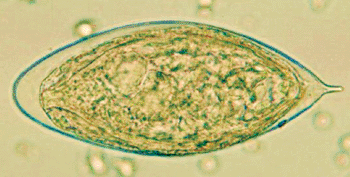Urinary Schistosomiasis Diagnosed by On-Chip Computer Imaging
By LabMedica International staff writers
Posted on 22 Jan 2014
The universal diagnostic method for detection of most globally important parasitic infections is by microscopy as it is relatively easy to perform at low cost.Posted on 22 Jan 2014
However, the quality control for microscopy is hard to maintain and misdiagnosis is common, which affects both estimates of parasite burdens and patient care.

Image: Schistosoma haematobium egg in a wet mount of urine concentrates, showing the characteristic terminal spine (Photo courtesy of Centers for Disease Control and Prevention).
Scientists at the Karolinska Institutet (Stockholm, Sweden) and their Finnish colleagues used novel techniques for high-resolution imaging and image transfer over data networks to offer solutions to these problems through provision of education, quality assurance, and diagnostics. They studied the basic technique of imaging an object directly on the surface of an image sensor chip of a webcam or a mobile phone camera.
The studies were performed on urine sediment obtained by pooling urines from individuals shown to excrete Schistosoma haematobium eggs. For on-chip trials, aliquots of the sediment were diluted in saline to give a concentration of about 250 eggs per mL. For part of the samples they used a microscope (Leica; Wetzlar, Germany) equipped with an AxioCam digital camera (Carl Zeiss; Oberkochen, Germany). Imaging software on a desktop computer was used for image capture.
On-chip imaging was performed essentially by placing the specimen in contact with an image sensor, which was then illuminated to produce a shadow of objects present in the specimen. The Complementary Metal Oxide Semiconductor sensor chip of an imaging device was made available for imaging tests by removing the optics. The main results were obtained with the exposed sensor of a low cost webcam (Creative Technology Ltd.; Singapore).
The results of the study showed that an inexpensive webcam stripped off its optics to allow direct application of the test sample on the exposed surface of the sensor, yields images of S. haematobium eggs, which can be identified visually. Using a highly specific image pattern-recognition algorithm, four out of five eggs observed visually could be identified. On-chip imaging investigations performed using stool samples containing various helminth eggs showed that eggs from helminths of different species could be distinguished from each other. The system can be exploited for constructing simple imaging devices for low-cost diagnostics of urogenital schistosomiasis and other neglected tropical infectious diseases.
The authors concluded that a decisive advantage of a minimicroscope such as the one they describe might prove to have the potential of providing diagnostic support by computer vision at a distance. Furthermore, their results suggest that diagnostics based image analysis has a potential to compete with laborious conventional microscopy by providing automated motion recognition for the detection of live nematode larvae. The study was published on December 5, 2013, in the journal Public Library of Science Neglected Tropical Diseases.
Related Links:
Karolinska Institutet
Leica
Carl Zeiss













